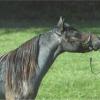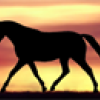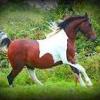Wild Horse colors ...photo EXPLOSION, 30 pics!
Forums
Re: Wild Horse colors (picture EXPLOSION!)
Re: Wild Horse colors ...photo EXPLOSION, 30 pics!
I was thinking just the same. OK they are not oil paintings but, have you noticed how, in these animals left to breed themselves and find their own level, not only are they pretty colours and interestingly marked, but they are also the correct length of back (although some are so short I should NOT like to try to sit a buck on them!!) and not nearly as plug ugly and awfully conformed as half the animals offered on Craig's List as "breeding prospects"
Perhaps Mother Nature does know best?
I hope they get homes, they need sterilising as well....FHOTD is doing a blog on Mustangs and rehoming them correctly, at the moment.
Re: Wild Horse colors ...photo EXPLOSION, 30 pics!
[quote="Dogrose"]Imagine what fun it would be to go there and choose one.[/quote]
How funny that I just read this, because as I was slowly scrolling down through the photos to read the replies, I was thinking to myself about how 'wild' a mustang is and wondering if they couldn't turn into great riding horses with the right amount of work ... similar to the work I do [i]in taming feral cats[/i] while creating a close and intimate bond based in trust and respect.
My husband and I both agree that some of our most favorite and personable cats, were former died-in-the-wool ferals before I worked my charms and wormed my way into their hearts just as firmly as they wormed their way into our own hearts.
Re: Wild Horse colors ...photo EXPLOSION, 30 pics!
I was just thinking the same, these are not bad looking horses. Thick, well muscled, fairly balanced, big feet; I wouldn't want to breed them, but they're better than many domestics. I do think the herds are managed to some extent - did anyone ever see the Nature documentary on Cloud? I remember they "let go" the pretty colors, for instance. Awesome photos
Re: Wild Horse colors ...photo EXPLOSION, 30 pics!
It could be eliminated, but only if they tested EVERY SINGLE horse, which is just not going to happen. I'm sure the evidence is lost. To the benefit of some predator that DOES need food to survive after all. In cases like this I really don't mind it. It's truly the circle of life. I'm more curious at the percentages in a wild breeding situation like this. Culling all carriers would be a HUGE loss. Much larger than the loss of the 25% of foals who happen to be out of two carriers.
Re: Wild Horse colors ...photo EXPLOSION, 30 pics!
[img]http://i973.photobucket.com/albums/ae21…]
handsome boy! :love
but WHY do they have to dump that rich hay in front of them right away? :hammer everyone knows you have to take it easy with a horse not used to geting food like that that easily. just look out behind the fence, [i]that[/i] is what they have been eating. :roll:
Re: Wild Horse colors ...photo EXPLOSION, 30 pics!
It seems to works for them.
[size=85]...does green hay automatically = rich hay?[/size] I'm pretty sure that is a grass hay and not alfalfa.
The OP stated many of those horses have been there for weeks so I imagine they've been introed through hay and progressed to that? I also understand the OP highly respects the people who work these 'pens' and those employees have been, on average, working there for 15-30yrs and are horsemen/women. I'm sure they know what they're doing.
OP also 'works' closely with the peeps who manage those 'pens', in addition to the peeps who work the gathers. She is a frequent visitor to the wild ranges herself to check the condition of the range, waterholes, horses, livestock, wildlife and has written a book about the mustang herd management areas around her.
Re: Wild Horse colors ...photo EXPLOSION, 30 pics!
Oh, I know it. Heck, I've met lots of people that I think still don't have a clue about themselves, let alone anything else.
My thoughts are, since reading many of that person's posts, is that she is knowledgeable and *would* speak out if she saw things that were wrong. She comes across as a person who cares more about the horses than sparing any person's feelers.
Re: Wild Horse colors ...photo EXPLOSION, 30 pics!
They throw that kind of hay out because they don't have anything else and those high desert grasses wouldn't last a day if they were to try to grow enough to keep the horses in grass pans. As for caring for the horses there - well, Burns is a very cold place in the winter with wind chills way below freezing a LOT and long hot dry summers in the upper 90's...there's not one shelter in any of those pens so those horses are exposed to the elements with no protection. Oh I know they came from the wild with no shelters - but in actual fact those juniper trees form nice umbrellas and the horses do take advantage of that. I live a couple of hours from Burns, I'm in the High Desert, have been to the pens many time, have adopted from there (Kiger mustang) and have been to the HMA's to see the herds in their natural environment many times. You can see their favorite trees from how the sand under them is packed down.
Do they make nice riding horses?....Well, you won't find a better mined, hardier, sturdier, more sure footed horse anywhere and I don't care how fancy the breeding operation is :D
Also I'm 100% in agreement with the conformation comments. Long swan necks (yuk) long backs, QH type post legs, flat croups that domestic breeders seem to love etc just won't cut it in the wild. These horses are build like tanks (think Spanish type conformation) Their conformation allows them to move in the roughest of terrain (believe me - you can't walk 3 feet out there without being on a rock) eat the most meager of diets and tuck their hind legs under them to go down steep grades in a heatbeat. YES - when it comes to the horse Mother Nature DOES know best :toast :D The have shorter backs, short thicker set necks deep chests...very Spanish in type and built for use.
Re: Wild Horse colors ...photo EXPLOSION, 30 pics!
[quote]Also I'm 100% in agreement with the conformation comments. Long swan necks (yuk) long backs, QH type post legs, flat croups that domestic breeders seem to love etc just won't cut it in the wild. These horses are build like tanks (think Spanish type conformation) Their conformation allows them to move in the roughest of terrain (believe me - you can't walk 3 feet out there without being on a rock) eat the most meager of diets and tuck their hind legs under them to go down steep grades in a heatbeat. YES - when it comes to the horse Mother Nature DOES know best The have shorter backs, short thicker set necks deep chests...very Spanish in type and built for use.
[/quote]
I'm sorry to disagree but not one of those horses shows Spanish type. I only see draft/QH...maybe some Morgan in some of them.
The photos with "some" Spanish traits were some of the rear shots which were most likely very young horses.
Spanish is flat, smooth muscles not bunchy or creasy...neck set low in the chest, narrow chest well "veed" in front, deep heart girth, shoulder well sloped on a short back, rafter hip from the rear, lower than the whithers, rounded croup with legs well under the horse. Clean legged (no hair).
The mare in this pic has a fairly classic head with a refined muzzle... notice the foal shows it as well. The mare & foal are not related at all.
[img]http://i39.photobucket.com/albums/e156/…]
Re: Wild Horse colors ...photo EXPLOSION, 30 pics!
Oh no they're not Spanish looking. That's my bad with my explanation. I've had Spanish mustangs from the Sulphur herd, American Sorraia Mustangs and a half Portuguese Sorraia so I'm familiar with that type...I wasn't trying to say they were Spanish but was trying to simplify their type for the sake of the thread. It's more Spanish in type like teh American breeds descending from the Spanish mustangs - like the old Style Morgan/QH, than say the modern Arab with the longer necks and flatter croups. A lot of the Oregon herds have draft influence too. Although many of the Oregon herds - Sheepshead, Beatys Butte, Murders creek etc do genetically link in the Spanish groups and show strong Spanish markers.
Re: Wild Horse colors ...photo EXPLOSION, 30 pics!
I guess the misunderstanding lies with the different horses that are trying to fall under the title "Spanish Mustang". If they are BLM horses, they are not Spanish Mustangs. Spanish Mustangs are strictly those that are registered with the Spanish Mustang Registry (SMR) or Southwest Spanish Mustang Association (SSMA). early Sulphur horses like Doby, looked as straight as when the Utes raided them from the California & New Mexico estancias. Sulphur horses of today obviously have outside breeding. The straightest Sulphur horse that I've seen in recent years was Sulphur's Chance & several of his mares. That band must have been secluded for years to be that consistent. They are also SMR registered.
Kigers aren't straight either by their own admission.
Re: Wild Horse colors ...photo EXPLOSION, 30 pics!
The person who guessed would have meant a cross because I was asking what cross, I think they said Kiger X tb and people agreed. They didn't know I was in the UK.
Re: Wild Horse colors ...photo EXPLOSION, 30 pics!
The dam was the Spanish native, she was dun or grulla, I saw a photo but have forgotten which. She had two other foals by different sires, a strange fawn grulla and a grulla tobi. All have died now except this one who was the youngest and is getting on for 20. The sire was a top eventing stallion, I don't know anything else about him.
Re: Wild Horse colors ...photo EXPLOSION, 30 pics!
I had a Sulphur filly who was bred from parents from the earlier adoptions. She has a three inch wide dorsal stripe...pretty cool ';-) She was so Sorraia in type you couldn't tell them apart. I say Sorraia and not "Spanish" because the look is very different (as you obviously know from your posts) :D
Re: Wild Horse colors ...photo EXPLOSION, 30 pics!
Love the leg markings on this one . . . .
[img]http://i973.photobucket.com/albums/ae21…]
What would cause the white to be blacked out again? :?







Re: Wild Horse colors (picture EXPLOSION!)
[img]http://i973.photobucket.com/albums/ae21…]
[img]http://i973.photobucket.com/albums/ae21…]
[img]http://i973.photobucket.com/albums/ae21…]
[img]http://i973.photobucket.com/albums/ae21…]
[img]http://i973.photobucket.com/albums/ae21…]
[img]http://i973.photobucket.com/albums/ae21…]
[img]http://i973.photobucket.com/albums/ae21…]
[img]http://i973.photobucket.com/albums/ae21…]
[img]http://i973.photobucket.com/albums/ae21…]